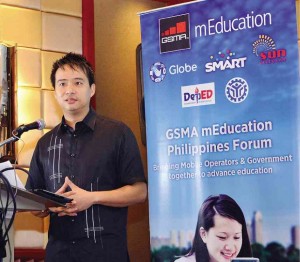Synchronizing mobile education

Charles A. Lim of Smart and Sun Cellular, Napoleon L. Nazareno of Smart and Irene Ng, GSMA head of Asia
When the GSM (Groupe Speciale Mobile) Association or GSMA came to the Philippines recently, it was not to introduce a new concept but to help optimize the impact, and broaden the reach, of existing initiatives.
It brought experience and expertise collected from some
220 countries and nearly 800 mobile operators to help local mobile service providers maximize and optimize their programs.
All mobile networks in the country—Smart Communications, Globe Telecom and Digitel Mobile Philippines (DMPI or Sun Cellular)—have educational programs as part of their corporate social responsibility initiatives.
But collaboration and coordination with government agencies and other stakeholders were spotty, each pursuing their own goals, increasing the risk of redundancy and duplication.
Article continues after this advertisementAnd the fiercely competitive networks hardly compared notes on what they were doing.
Article continues after this advertisementAt a one-and-a-half-day workshop, GSMA brought together the competing mobile networks, as well as government agencies at the forefront of the country’s education system, to synchronize, harmonize and sharply focus efforts for maximum effect.
Adviser and ally
Irene Ng, GSMA head for Asia, said the association was “acting as adviser for this mEducation (mobile education) initiative, providing support to include best practice and business model expertise.”
She stressed the significance of the event: “Never before has such an ambitious mEducation collaboration taken place in the Philippines, involving all three mobile network operators and two key government agencies.”
Ramon Isberto, Smart public affairs group head, said that by working with educators, they would be bringing in technology that was more effective and efficient.
He noted that Philippine mobile technology was rapidly changing. Sharply falling prices of digital tablets and smartphones allowed access to mobile technology even in remote areas, including communities without electricity but with solar power generators.
At an earlier press conference, Ronda Zelesny-Green, GSMA mEducation knowledge manager and regional lead for Asia, said the association’s primary goal in organizing the workshop was “to help create mobile opportunities to address barriers” in the delivery of education.
She said the Philippines, reputed to be the SMS (short message service) or text messaging capital of the world, could be a “proving ground” for what mobile education can do.
Adrien Godfrey, GSMA mEducation director, said at the same press conference that the workshop would seek ways to “simplify access and personalize education,” and strengthen collaboration between mobile operators and government agencies to make quality content for education applications.
Sustainable solutions
He said they hoped to generate sustainable solutions while allowing healthy competition in the multistakeholder partnership.
At the close of the workshop, Education Undersecretary for Partnerships and External Linkages Mario A. Deriquito said: “While mEducation is relatively new, I believe in the vast potential of mobile technology in education.”
The department, he said, had pretty much addressed most backlogs identified in 2010. A current priority was to come up with alternative, affirmative action for learners with special needs, such as Muslims, street children, indigenous peoples and out-of-school youth (OSY).
He said that at the start of 2014, the Department of Education (DepEd) would launch the program Abot Alam with other national government agencies, local governments and civil society groups to provide education and training services to at least
1 million OSY. The program hopes to reach 3 to 4 million OSY by 2016.
Deriquito said the DepEd wanted to engage the private sector in providing opportunities and resources for distance education, and to “use technology to expand the reach of basic education services through the provision of computers and other information technology (IT) equipment, and the roll-out of learning resources.”
He said: “The opportunities are limitless because of great strides in mobile technology and the increasing number of Filipinos with mobile devices. We are excited to see what mobile education solutions this partnership will generate, solutions that can help bring quality education to all Filipino learners, especially those that are hard to reach.”
Secretary Joel Villanueva, director general of the Technology Education and Skills Development Authority (Tesda), said they were “searching for new technologies for better and easier access to education and training,” as they realized that more people were learning with the use of tablets.
The Tesda, he said, was now using the Internet and mobile applications to reach grassroots learners. He said they had registered more than 128,000 online users.
Villanueva said that by working with mobile providers and GSMA, more youths would be able to get foundational, transferrable technical skills through innovative programs using IT.
Orlando B. Vea, DMPI president and chief executive officer, said Sun Cellular had been supporting “pervasive, appropriate and affordable mobile technologies as tools in enabling people and communities.”
Expressing support for mEducation, Ernest L. Cu, Globe Telecom president and CEO, said the company had long been committed to “using ICT (information and communication technology) solutions to help the education sector through mobile and broadband connectivity, and ICT-enabled content, and to promote 21st-century teaching methodologies.”
Napoleon L. Nazareno, Smart president and CEO, said the company recognized the crucial role mobile technology could play in “democratizing access of both young and adult learners to formal education” in line with the DepEd’s goal of education for all.
At the end of the workshop, the government agencies and the mobile networks signed a memorandum of agreement for partnership that GSMA described as “a groundbreaking cooperation.”
In a statement, GSMA said it would work with the partners to provide OSY “with additional opportunities to access education, including technical-vocational education, via mobile media.”
To be especially targeted for mEducation, according to the statement, would be learners in underserved areas and geographically isolated communities.
E-mail the author at [email protected].


